 |
 |
 |
 |
 |
 |
| |
 |
|
 |
 |
 |
  |
  |
 |
 |
 |
 |
| THE SHIP: A FLOATING PAVILION FOR CROATIA AT THE VENICE BIENNALE
|
|
August 26, 2010
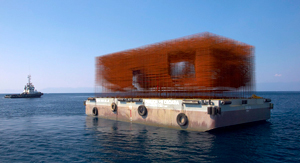 Croatian participation at the 12th International Architecture Exhibition at la Biennale di Venezia consists of three components: a Floating Pavilion, the exhibition of the project at the Croatian venue at the Arsenale, and a publication of the project distributed to visitors at the venue. Croatian participation at the 12th International Architecture Exhibition at la Biennale di Venezia consists of three components: a Floating Pavilion, the exhibition of the project at the Croatian venue at the Arsenale, and a publication of the project distributed to visitors at the venue.
The Pavilion
The Floating Pavilion is built on an existing barge with dimensions of 10m x 20m x 3m. The pavilion structure is in the form of a cargo of 32 tons of welded wire mesh, with more than 40 layers spaced so that they form a solid volume with approximate dimensions of 19m x 9m x 5,5m. Inside the volume is a carved out space shaped by varying contours that form the main space as well as protrusions and openings toward the outside. Almost invisible form a distance, the structure reveals itself with different densities of steel mesh, transparencies, and vision lines, forming stunning visual effects and experience of space by very simple means. The Croatian Pavilion is towed by a tugboat from the shipyard in Kraljevica to the port of Rijeka, to be presented to the public on 21 August 2010, and on to Venice to be moored at the main pier during the opening of the Biennale.
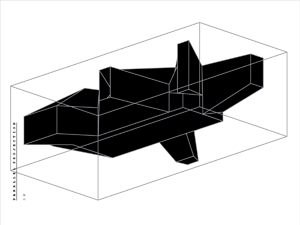 The Exhibition The Exhibition
Inside the Croatian exhibition space, the project documentation center has been set up in the form of cargo boxes printed with the records of the design process, the construction of the pavilion at the 280-year-old shipyard in Kraljevica, and its journey across the Adriatic. Lana Cavar and Narcisa Vukojević are responsible for graphic design of the exhibition, while Vjeran Šalomon made audio installation.
The Publication
Also as cargo, the project publication is presented in the form of 6 loose printed sheets with photo documentation, which when folded and bound make a 96 page book for everybody to take. The concept and the production of the publication is by Lana Cavar and Narcisa Vukojević. Marko Golub conducted the interviews.
The Authors
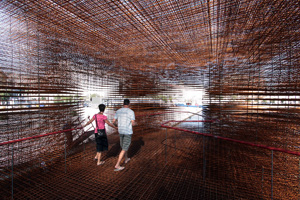 The authors of the project are 15 of the most distinguished Croatian architects of today, who through various practices and some of the most distinct buildings designed recently, are already recognized on the global architectural scene. They have established Croatian architecture as a relevant force. Here they have united into a single work team that has produced a common project and had it realized for the Croatian participation at La Biennale. Saša Begović, Marko Dabrović, Igor Franić, Tanja Grozdanić, Petar Mišković, Silvije Novak, Veljko Oluić, Helena Paver Njirić, Lea Pelivan, Toma Plejić, Goran Rako, Saša Randić, Idis Turato, Pero Vuković and Tonči Žarnić met in more than 20 work sessions and innumerable other meetings and site visits. The authors of the project are 15 of the most distinguished Croatian architects of today, who through various practices and some of the most distinct buildings designed recently, are already recognized on the global architectural scene. They have established Croatian architecture as a relevant force. Here they have united into a single work team that has produced a common project and had it realized for the Croatian participation at La Biennale. Saša Begović, Marko Dabrović, Igor Franić, Tanja Grozdanić, Petar Mišković, Silvije Novak, Veljko Oluić, Helena Paver Njirić, Lea Pelivan, Toma Plejić, Goran Rako, Saša Randić, Idis Turato, Pero Vuković and Tonči Žarnić met in more than 20 work sessions and innumerable other meetings and site visits.
The Commissioner
The Commissioner Leo Modrčin proposed the pavilion on a barge as a simple solution for Croatia's need for space at the Venice Biennale and as a symposium of multiple ideas and projects to be exhibited at la Biennale. Instead, he found himself moderating the rare and dramatic process of architectural teamwork and construction, which resulted in a singular and most inspiring work of architecture.
The Support
Besides the Croatian Ministry of Culture, which generously accepted all the uncertainties of the design and building process, the project is supported by the organizer, the Museum of Modern and Contemporary Art in Rijeka, the Croatian port city where most of the maritime and shipbuilding industries and services supporting the project are based. The main sponsors are Shipyard Kraljevica/fabrication, 3.maj Shipyard Rijeka/barge and Jadranski pomorski servis/towing. AVC Zagreb provides exhibition support.
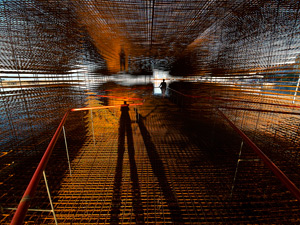 The Commissioner's Statement / from the book's introduction The Commissioner's Statement / from the book's introduction
..... At the point of this writing, it is still uncertain when the pavilion will reach Venice after touching the homeports on the Croatian coast of the Adriatic. Not to accomplish the full circle and reach the final destination after this extraordinary effort by its creators and the numerous members of the local maritime industry would be simply wrong. In our usual ways of architectural spin masters, we could justify the process of design itself without the final materialization as a valid and as the most literal of responses to the theme proposed by Ms. Sejima. It is a meeting of great architectural minds, completely realized as accomplished architects, who have accepted the uncertainty of the unusual project and now generously share this profound personal experience of working in an unstable group setting with the general public.
Yet, without the actual construction and navigation to Venice, we would have never been able to gather all the parameters of the project and prove the feasibility of the whole premise that a floating pavilion was a possible way to go. For this group of architects there was simply no alternative. The construction on the barge has been a monumental task in itself. Designed by 14 authors, it is fabricated by a dozen welders who put in a countless number of welds in order to build the structure. It consists of 42 layers of Q385 weeded wire mesh put together by welding each layer on vertical rods spaced 50 cm in either direction. It is a fragile construction despite the 32 tons of steel, perhaps just a fraction of material expected to conquer such a volume of space. The solid part is everything but solid and it fully disappears when viewed from a distance, only to reappear as a heavy shield of steel when inside. Entering it somehow feels like entering a wire frame drawing, a raw armature of space before it is rendered into a full glory of a simulated, complete rendering of architecture. But here you are the rendering device. This must be architecture.
And you want to meet in it and share it. Especially when the 32 tons of welded wire mesh start shimmering as the waves bounce the entire structure as if it were a gull feather in the breeze. Some might try to prove it wrong to think that it is appropriate for an art and architecture pavilion to be a bit shaky, unstable, and even dangerous at times. But I am saying without any hesitation that the group of Croatian architects has produced an exceptional work of architecture. As it leaves the shipyard, it only now starts unloading its meanings, problems, beauty, truths, inspirations, and aspirations... Please follow its maiden voyage at www.pavilion.hr
Participants' Biographies
Sasa Begović was born 1967. in Bjelovar, Croatia. He graduated from the Architectural Faculty, University of Zagreb. He was guest lecturer at the Technical University in Graz and now he is guest lecturer at the Split Faculty of Architecture. He regularly lectures at universities throughout the world. He was editor‐in‐chief of the Croatian architectural magazine Man and Space. He is a founding partner and Principal Architect of 3LHD Architects. 3LHD is an architectural practice focused on integration of various disciplines – architecture, urban planning, design, and art. Projects, such as the Croatian Defenders’ Memorial Bridge in Rijeka, Bale Sports Hall, the Croatian pavilion at EXPO 2005 in Japan, Split waterfront, and Zamet Centre in Rijeka are some of the highlights of the practice. The work of 3LHD has been presented at important universities, exhibitions, and institutions all over the world. It received important Croatian and international awards, including the WAF 2008 Award at the First World Architecture Festival, IOC/IAKS Award, AR Emerging Architecture Award, ID Magazine Award and most important Croatian professional awards: D.Galic, B.Bernardi, V.Kovacic and V.Nazor Awards.
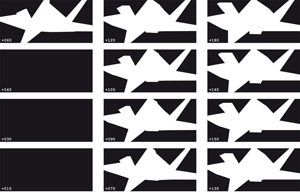 Marko Dabrović was born in 1969. in Dubrovnik, Croatia. He graduated from the Faculty of Architecture, University of Zagreb. In 1991 he founded the RNA Computer Visualization Studio. Since 2002 he has been a member of the CAA Professional Council, since 2003 a member of UMAR, and since 2005 a member of the Europan Croatia National Committee. He is also a licensing expert of the Croatian Football Association in the UEFA. He is a founding partner and Principal Architect of 3LHD Architects. 3LHD is an architectural practice focused on integration of various disciplines – architecture, urban planning, design, and art. Projects, such as the Croatian Defenders’ Memorial Bridge in Rijeka, Bale Sports Hall, the Croatian pavilion at EXPO 2005 in Japan, Split waterfront, and Zamet Centre in Rijeka are some of the highlights of the practice. The work of 3LHD has been presented at important universities, exhibitions, and institutions all over the world. It received important Croatian and international awards, including the WAF 2008 Award at the First World Architecture Festival, IOC/IAKS Award, AR Emerging Architecture Award, ID Magazine Award and most important Croatian professional awards: D.Galic, B.Bernardi, V.Kovacic and V.Nazor Awards. Marko Dabrović was born in 1969. in Dubrovnik, Croatia. He graduated from the Faculty of Architecture, University of Zagreb. In 1991 he founded the RNA Computer Visualization Studio. Since 2002 he has been a member of the CAA Professional Council, since 2003 a member of UMAR, and since 2005 a member of the Europan Croatia National Committee. He is also a licensing expert of the Croatian Football Association in the UEFA. He is a founding partner and Principal Architect of 3LHD Architects. 3LHD is an architectural practice focused on integration of various disciplines – architecture, urban planning, design, and art. Projects, such as the Croatian Defenders’ Memorial Bridge in Rijeka, Bale Sports Hall, the Croatian pavilion at EXPO 2005 in Japan, Split waterfront, and Zamet Centre in Rijeka are some of the highlights of the practice. The work of 3LHD has been presented at important universities, exhibitions, and institutions all over the world. It received important Croatian and international awards, including the WAF 2008 Award at the First World Architecture Festival, IOC/IAKS Award, AR Emerging Architecture Award, ID Magazine Award and most important Croatian professional awards: D.Galic, B.Bernardi, V.Kovacic and V.Nazor Awards.
Igor Franić was born in Zagreb 1963. He graduated from the Faculty of Architecture of the Zagreb University. After the graduation he worked in London. He has an independent practice and since 1996 he has been working as Associate Professor at the Faculty of Architecture of the Zagreb University. He received an award for his competition project of the Pharmaceutical and Biochemical Faculty at the 35th Zagreb Salon 2002. His major built projects are: Kindergarten in Ston (1995), Museum of Contemporary Art Zagreb (2009), and Mercator residential and commercial building, Zagreb (2007). His major unbuilt projects are: competition project for a sports complex with a swimming pool, Pula, 2nd prize (2003), Pile, Dubrovnik competition, 1st prize (2003), competition project for the Music Academy in Zagreb, 2nd prize (2'004). His most important participations at exhibitions are: Magazzini del sale, MCA, Venice (2007), Croatian Contemporary Architecture, Turin (2008), Contemporary Croatian and Slovenian Architecture, Harvard, USA (2008) He has held a series of lectures on his work.
Tanja Grozdanić was born 1968 in Zagreb, Croatia. She graduated from the Faculty of Architecture, University of Zagreb, Croatia. She was a guest critic at different EU universities and workshops and a member of several national architectural juries. She is a founding partner and Principal Architect of 3LHD Architects. 3LHD is an architectural practice focused on integration of various disciplines – architecture, urban planning, design, and art. Projects, such as the Croatian Defenders’ Memorial Bridge in Rijeka, Bale Sports Hall, the Croatian pavilion at EXPO 2005 in Japan, Split waterfront, and Zamet Centre in Rijeka are some of the highlights of the practice. The work of 3LHD has been presented at important universities, exhibitions, and institutions all over the world. It received important Croatian and international awards, including the WAF 2008 Award at the First World Architecture Festival, IOC/IAKS Award, AR Emerging Architecture Award, ID Magazine Award and all most important Croatian professional awards: D.Galic, B.Bernardi, V.Kovacic and V.Nazor Awards.
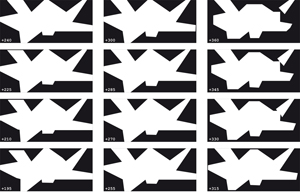 Helena Paver Njirić, born in 1963, graduated from the Faculty of Architecture in Zagreb in 1989. Since 2002 she has her own practice hpnj+ in Zagreb. She works on projects concerned with research and planning of urban space, landscaping, residential architecture, sustainable re‐use and reconstruction, as well as modalities of planning and construction in natural or rural context of transitional conditions. She has received several national and international awards and competition prizes. She has organized several solo exhibitions and participated in numerous international selections. She was included in the Shortlisted 40 of the Mies Award 2009 (Jasenovac) and 2007 (Rovinj). She was the Commissioner for the Croatian pavilion at the Venetian Biennale in 2004.Since 2008 she has been Associate Professor at the Faculty of Architecture in Zagreb and was a guest lecturer at the KTH Stockholm and TU Berlin from 2001 to 2003 and at the Università di Camerino in Ascoli in 2005. From 2006 to 2009 she was a member of the Gestaltungsbeirat in Salzburg. Built projects: Moire – time‐specific installation, MAXXI, Rome, 2010 / Permanent display of the Memorial Museum Jasenovac 2007 / Stanga housing, Rovinj 2004 / McDonald’s, Maribor 2000 / Baumaxx, Maribor 1999. Her works were published in The Phaidon Atlas 2008 (Jasenovac) and 2005 (Rovinj) / 10 x 10, Phaidon 2000 . A monograph issue of El Croquis – 114(II) ‐ was published on her work in 2003. Helena Paver Njirić, born in 1963, graduated from the Faculty of Architecture in Zagreb in 1989. Since 2002 she has her own practice hpnj+ in Zagreb. She works on projects concerned with research and planning of urban space, landscaping, residential architecture, sustainable re‐use and reconstruction, as well as modalities of planning and construction in natural or rural context of transitional conditions. She has received several national and international awards and competition prizes. She has organized several solo exhibitions and participated in numerous international selections. She was included in the Shortlisted 40 of the Mies Award 2009 (Jasenovac) and 2007 (Rovinj). She was the Commissioner for the Croatian pavilion at the Venetian Biennale in 2004.Since 2008 she has been Associate Professor at the Faculty of Architecture in Zagreb and was a guest lecturer at the KTH Stockholm and TU Berlin from 2001 to 2003 and at the Università di Camerino in Ascoli in 2005. From 2006 to 2009 she was a member of the Gestaltungsbeirat in Salzburg. Built projects: Moire – time‐specific installation, MAXXI, Rome, 2010 / Permanent display of the Memorial Museum Jasenovac 2007 / Stanga housing, Rovinj 2004 / McDonald’s, Maribor 2000 / Baumaxx, Maribor 1999. Her works were published in The Phaidon Atlas 2008 (Jasenovac) and 2005 (Rovinj) / 10 x 10, Phaidon 2000 . A monograph issue of El Croquis – 114(II) ‐ was published on her work in 2003.
Lea Pelivan was born in Split in 1976. She graduated from the Architectural Faculty of the Zagreb University. In 2003 she founded STUDIO UP with Toma Plejić – a Zagreb‐based architectural practice focused on contemporary architecture and city‐planning. She was awarded the Grand Prix at the 38th Zagreb Salon 2003, and received the Viktor Kovačić (2008), Vladimir Nazor (2008), and Drago Galić (2009) Awards. She also received a Special Mention of the Mies van der Rohe Award for Emerging Architects in 2009. She participated at the exhibitions Mare Nostrum and Power Lounge, which were part of the second and the third editions of the International Architecture Biennale in Rotterdam, Balkanology in Basel, Peacebuilding in Rome, and New Trajectories; Contemporary Architecture in Croatia and Slovenia in Boston. In 2004 she represented Croatia at the Venice Biennale. She was guest lecturer in Vienna, Boston, Essen, Leuven, Lisbon, Ljubljana, Split, and Zagreb.
Petar Mišković was born in Rijeka, 1974. He graduated from the Faculty of Architecture of the Zagreb University. Since 2000 he has been a free‐lance architect based in Rijeka and Zagreb. Since 2002 he has been lecturing at the Faculty of Architecture of the Zagreb University. He collaborates with other architects and artists. He focuses on pavilion architecture and the architecture of residential and public buildings. He was awarded the first prize of the Zagreb Salon of Architecture and the national prize for residential architecture Drago Galić in 2003. He represented Croatia at the Venice Biennale in 2004.
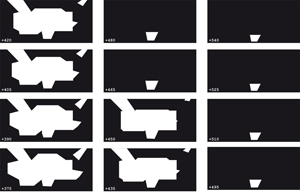 Leo Modrčin is an architect working in Rijeka, Croatia and New York, USA. He is the architect of the acclaimed 59E59 Theaters building in New York City, which was awarded the Viktor Kovačić Prize in Croatia. He also designed a subsidized housing project in Kraljevica, Croatia. He graduated from the Faculty of Architecture, University of Zagreb in 1984 and obtained a Master’s Degree at Pratt Institute in Brooklyn, New York, in 1988. He taught in the graduate architecture department at Pratt and was a visiting professor at the School of Architecture, SUNY, at Buffalo in 2006. In 2008 he became Adjunct Professor at the Faculty of Architecture in Zagreb. His work was recognized in a number of architectural competitions, including the first prize at the 11th Membrane Design Competition in Japan in 1996, the second prize for the Public Library in Rijeka in 2006 etc. His projects and essays on architecture have been published in numerous architectural publications. Leo Modrčin is an architect working in Rijeka, Croatia and New York, USA. He is the architect of the acclaimed 59E59 Theaters building in New York City, which was awarded the Viktor Kovačić Prize in Croatia. He also designed a subsidized housing project in Kraljevica, Croatia. He graduated from the Faculty of Architecture, University of Zagreb in 1984 and obtained a Master’s Degree at Pratt Institute in Brooklyn, New York, in 1988. He taught in the graduate architecture department at Pratt and was a visiting professor at the School of Architecture, SUNY, at Buffalo in 2006. In 2008 he became Adjunct Professor at the Faculty of Architecture in Zagreb. His work was recognized in a number of architectural competitions, including the first prize at the 11th Membrane Design Competition in Japan in 1996, the second prize for the Public Library in Rijeka in 2006 etc. His projects and essays on architecture have been published in numerous architectural publications.
Silvije Novak was born 1971 in Rijeka, Croatia. He graduated from the Faculty of Architecture, University of Zagreb, where he now works as guest lecturer. He is a member of the CAA Professional Council. He was the executive editor of the Croatian architectural magazine Man and Space. He is a founding partner and Principal Architect of 3LHD Architects. 3LHD is an architectural practice focused on integration of various disciplines – architecture, urban planning, design, and art. Projects, such as the Croatian Defenders’ Memorial Bridge in Rijeka, Bale Sports Hall, the Croatian pavilion at EXPO 2005 in Japan, Split waterfront, and Zamet Centre in Rijeka are some of the highlights of the practice. The work of 3LHD has been presented at important universities, exhibitions, and institutions all over the world. It received important Croatian and international awards, including the WAF 2008 Award at the First World Architecture Festival, IOC/IAKS Award, AR Emerging Architecture Award, ID Magazine Award and most important Croatian professional awards: D.Galic, B.Bernardi, V.Kovacic and V.Nazor Awards.
Veljko Oluić was born in Bjelovar 1954. He graduated from the Faculty of Architecture of the Zagreb University 1979. He has worked at the Faculty of Architecture in Zagreb since 1980, since 2010 as Full Professor. He is the author or a co‐ author of a series of architectural designs (reaching from initial sketches to execution projects) and built projects. He won a number of prizes in architectural competitions and awards, e.g. at the Youth Salon (special mention 1987, with Tonči Žarnić) and Zagreb Salon (project award and the Grand Prix of the Salon 1994, with T. Žarnić); Viktor Kovačić Yearly Award for the best built project in 2005 (with T. Žarnić); second prize at the 41st Zagreb Salon 2006 (with T. Žarnić). He participated at many exhibitions in Croatia and abroad. His selected built projects are: Industrial and Crafts School in Zadar (with T. Žarnić), Pavilion 6 of the Faculty of Agronomy in Zagreb (with H. Auf‐Franić) and a family house in Kustošija.
Pero Vuković, born 1989, is a student of the Architectural Faculty of the Zagreb University since 2007. He has attended different architectural and art workshops. He received the Chancellor's Award for 2010. He participated at architectural and city‐planning competitions and won several prizes, two of which were first prizes. At the Faculty of Architecture he participated in the courses Design Studies 1 and 2 and Architectural Design 1 and 2, in the capacity of Teaching Assistant.
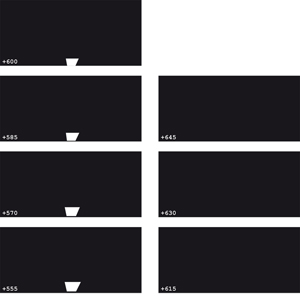 Goran Rako was born in Imotski 1952. In 1977 he participated at the competition for the Museum in Jablanica (with M. Pecotić). In 1978 he graduated from the Faculty of Architecture in Zagreb and designed the Periscope House. From 1990 to 1998 he worked with B. Radonić. In 1991he participated at the competition for the Nara Congress Centre, in 1993 he designed the projects for Den Bosch residential settlement and the hospital in Nova Bila (with A. Kuzmanić and D. Marasović). In 1994 he participated at the competition for the Southern Arcade of Mirogoj. In 1997 he received an award for his project at the Zagreb Salon. In 1999 he designed the residential building B. In 2000 he became a lecturer at the Faculty of Architecture in Zagreb, 2001 he won the competition for the Narona Museum in Vid, and 2003 he received the Viktor Kovačić Award. In 2004 he founded his practice Radionica arhitekture (Architecture Workshop) and participated at the competition for a kindergarten in Sesvete. In 2005 he participated at competitions for a building in Tkalčićeva Street and a school in Špansko. In 2007 he participated at the competition for the Vukovar Watertower, received the Vladimir Nazor Prize, and became President of the CAA. In 2008 he designed the Archaeological Museum in Vučedol. Since 2009 he has been teaching the course Tourism Structures at the Faculty of Architecture in Zagreb. Goran Rako was born in Imotski 1952. In 1977 he participated at the competition for the Museum in Jablanica (with M. Pecotić). In 1978 he graduated from the Faculty of Architecture in Zagreb and designed the Periscope House. From 1990 to 1998 he worked with B. Radonić. In 1991he participated at the competition for the Nara Congress Centre, in 1993 he designed the projects for Den Bosch residential settlement and the hospital in Nova Bila (with A. Kuzmanić and D. Marasović). In 1994 he participated at the competition for the Southern Arcade of Mirogoj. In 1997 he received an award for his project at the Zagreb Salon. In 1999 he designed the residential building B. In 2000 he became a lecturer at the Faculty of Architecture in Zagreb, 2001 he won the competition for the Narona Museum in Vid, and 2003 he received the Viktor Kovačić Award. In 2004 he founded his practice Radionica arhitekture (Architecture Workshop) and participated at the competition for a kindergarten in Sesvete. In 2005 he participated at competitions for a building in Tkalčićeva Street and a school in Špansko. In 2007 he participated at the competition for the Vukovar Watertower, received the Vladimir Nazor Prize, and became President of the CAA. In 2008 he designed the Archaeological Museum in Vučedol. Since 2009 he has been teaching the course Tourism Structures at the Faculty of Architecture in Zagreb.
Saša Randić (1964 Rijeka, Croatia) graduated from the University of Zagreb, Faculty of Architecture (1990). In the following period he joined the Post‐graduate Program at the Berlage Institute in Amsterdam, where he received his MA in 1992, being among the Institute's very first generations. From 2003 to 2007 he was President of the Croatian Architects’ Association. In 2009 he started the architecture blog pogledaj.to that operates as a research studio of his architectural office. Together with Idis Turato, Sasa Randić founded Randic‐Turato Architects in 1993. They received the Viktor Kovačić Award for the extension of the Technical Faculty in Rijeka in 2004, for the Pope John Paul II Hall in 2008 and for the DVKF kindergarten in 2009. The elementary School in Krk received the Piranesi Award in 2005 and the Croatian state prize Vladimir Nazor in 2006. The same building was included in the selection of the 2007 Mies van der Rohe Award. In 2006 they represented Croatia at the 10th International Architecture Exhibition at the Venice Biennale.
Toma Plejić was born in Rijeka 1977. He graduated from the Faculty of Architecture of the Zagreb University in 2001. In 2003 he founded STUDIO UP with Lea Pelivan – a Zagreb‐based architectural practice focused on contemporary architecture and city‐planning. He was awarded the Grand Prix at the 38th Zagreb Salon 2003, and received the Viktor Kovačić (2008), Vladimir Nazor (2008), and Drago Galić (2009) Awards. He also received a Special Mention of the Mies van der Rohe Award for Emerging Architects in 2009. He participated at the exhibitions Mare Nostrum and Power Lounge, which were part of the second and the third editions of the International Architecture Biennale in Rotterdam, Balkanology in Basel, Peacebuilding in Rome, and New Trajectories; Contemporary Architecture in Croatia and Slovenia in Boston. In 2004 he represented Croatia at the Venice Biennale. He was guest lecturer in Vienna, Boston, Essen, Leuven, Lisbon, Ljubljana, Split, and Zagreb.
Idis Turato (born in Rijeka 1965.) graduated from the Faculty of Architecture of the Zagreb University in Zagreb in 1991. He received his MA at the same faculty in 2004. Since 2007 he has been lecturing at the Faculty of Civil Engineering and Architecture in Split. Together with Sasa Randic, Idis Turato founded Randic‐Turato Architects in 1993. They received the Viktor Kovačić Award for the extension of the Technical Faculty in Rijeka in 2004, for the Pope John Paul II Hall in 2008 and for the DVKF kindergarten in 2009. The elementary School in Krk received the Piranesi Award in 2005 and the Croatian state prize Vladimir Nazor in 2006. The same building was included in the selection of the 2007 Mies van der Rohe Award. In 2006 they represented Croatia at the 10th International Architecture Exhibition at the Venice Biennale.
Tonći Žarnić was born in 1956. He graduated from the Faculty of Architecture of the Zagreb University in 1981. He has been lecturing at the Faculty of Architecture of the Zagreb University since 1988. He is currently a Professor at the Architectural Design Department, teaching the courses Architectural Design 1 and 2 and Architectural Workshop 2. For his architectural work he received several national awards. He lives in Zagreb
|
|
 |
  |
 |
|
|